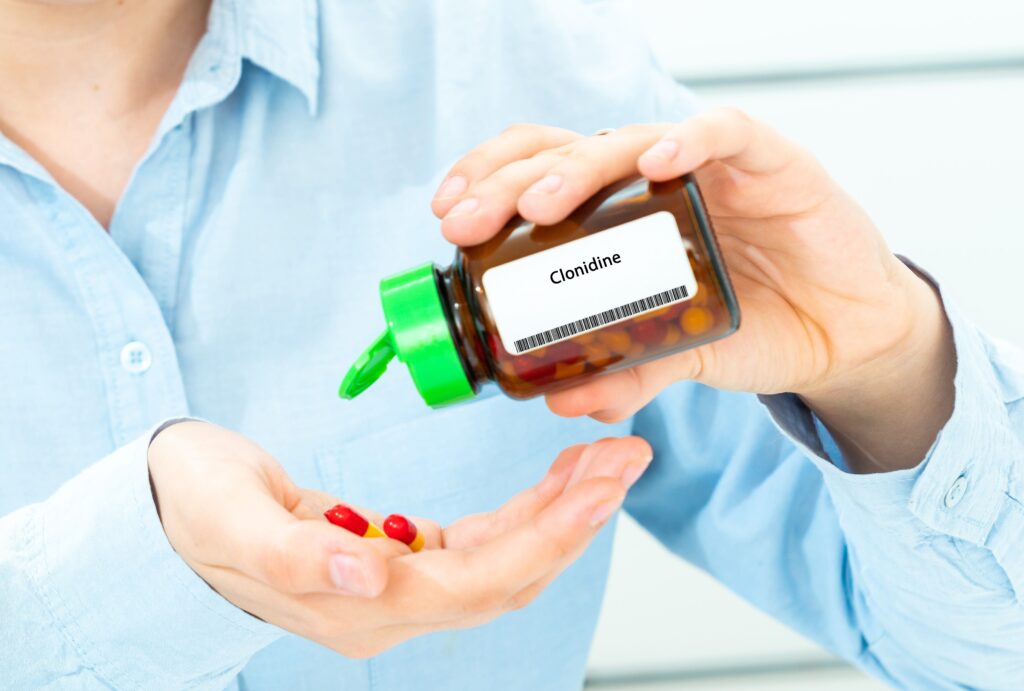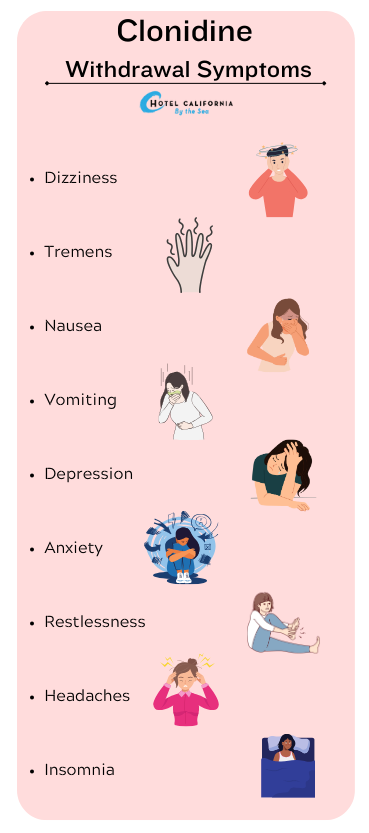Clonidine Withdrawal Symptoms
Clonidine hydrochloride is a medication classified as an antihypertensive and centrally acting alpha agonist. It was FDA-approved to treat high blood pressure, ADHD in children, Tourette syndrome-related tics, cancer-related pain, and stress-related pain. It can also be used to help treat restless leg syndrome. In 2016, clonidine was the 79th most prescribed medication in the United States. According to the National Survey on Drug Use and Health, an estimated 0.2% of the population was misusing prescription sedatives such as clonidine. In 2020, US doctors wrote about 9 million prescriptions for clonidine.

Clonidine is the generic name of the drug and is only available through a prescription. It is normally administered through an oral tablet or patch form. Brand names of the drug include Catapres, Kapvay and Nexiclon XR. Clonidine is not a scheduled medication and is generally considered a low risk for addiction.
The prescription medication is commonly used for off-label treatment and management of opioid withdrawal, benzodiazepine withdrawal and alcohol withdrawal. Because the drug impacts the central nervous system, it can reduce the symptoms of withdrawal such as sweating, hot flashes, watery eyes and more. It also helps relieve the intensity of anxiety, agitation and elevated heart rate. Being used in combination with other drugs to treat other conditions can mean patients are at risk for developing dependence and addiction to clonidine.
This means substance abuse could develop while using it per the recommendation of treatment care. In addition, when it is being used and mixed with other drugs such as benzos, opioids or alcohol, clonidine can intensify the sedative effects of the drug and cause the user to feel even further detachment from reality. This only exacerbates the user’s need to continue abusing the drug.
How does Clonidine work?
Clonidine works by blocking the chemicals in the brain that trigger the sympathetic nervous system activity. It affects the release of norepinephrine, a hormone and neurotransmitter involved in the body’s stress response and reward system. It reduces pain signals from the spinal cord to the brain. In turn, it can result in feelings of relaxation and decreased pain. The drug relaxes the blood vessels and allows the blood to move more freely throughout the body, which also helps with lowering blood pressure.
The drug activates the alpha-2 adrenergic receptors in the brain. It slows down the heart rate and reduces the amount of blood pumped causing a decrease in brain and physical activity. It reduces hyperactivity of the nervous system, which can minimize the intensity of withdrawal symptoms from opioids, benzos and alcohol. There is no feeling of euphoria or high associated with clonidine. The drug simply reduces the effects on the central nervous system.
Clonidine’s half-life is between 5-13 hours. For chronic users or those with severe or impaired kidney functions, it can take an estimated 48-72 hours for the body to eliminate the drug. Clonidine is most often used in detox treatments and medication-assisted treatments. In fact, clonidine is used in about 80% of detox treatment plans. It is recommended for short-term use during the detox stage, which usually lasts around seven days.

Signs you may have a Clonidine dependency
- Feeling an intense urge to use clonidine
- Feeling the need to use clonidine regularly
- Taking more clonidine in order to achieve the same desired effects
- Wanting to ensure there is always a backup of clonidine
- Spending way too much time using clonidine and neglecting responsibilities and giving up hobbies you once enjoyed.
- Spending more money on clonidine than you can afford. It can take a financial toll.
- When you cannot picture yourself quitting clonidine
- Hiding your clonidine drug use from friends, families and colleagues
- You experience withdrawal side effects such as nausea, vomiting, insomnia and anxiety when you try to quit clonidine
Common physical side effects of clonidine abuse include constipation, nausea, vomiting, headache and weakness. Other chronic side effects that can develop include agitation, anxiety, hallucinations, insomnia, depression, lack of coordination, sedation and slurred speech. When users begin to experience these symptoms, they become dependent on the clonidine and can also experience withdrawal symptoms when they decide to stop or drastically decrease drug use.
Check Your Insurance Coverage for FREE
Find out if your insurance covers addiction treatment in minutes. We accept most insurance!
Clonidine Withdrawal Symptoms
Clonidine withdrawal symptoms occur when there is a sudden increase in activity of the sympathetic nervous system. This happens when there is an abrupt and drastic termination of drug use. When activity increases, the overactive neurons can also produce a sudden rise in blood pressure and other side effects. Withdrawal symptoms can vary in intensity and duration for each client. The average duration of withdrawal symptoms can last for several weeks with the first set of symptoms occurring about 12 hours from the last dose.
- Anxiety and depression
- Insomnia – an increase in anxiety can turn into restlessness
- Nervousness
- Agitation and irritability – you find it difficult to stay reasonable and sense multiple issues without reason
- Dizziness and lightheadedness
- Shivering and tremors
- Nausea and vomiting
- Difficulty concentration
- Increased heart rate and blood pressure
- Tightness in the chest
- Restlessness
- Mood swings
- Clonidine Rebound Hypertension – this occurs when there is a sudden rise in blood pressure and stress levels due to the decrease or cessation of clonidine medication in the system. The effect is temporary and can cause symptoms such as headache, dizziness, or coronary heart palpitations.
When it comes to withdrawing from a medication like clonidine, a gradual taper is the best method of detoxification. This involves slowly reducing drug intake over a period of 2-4 weeks. It is the most preferred and effective method when treating withdrawal and addiction to clonidine.
Reach out to Hotel California by the Sea
We specialize in treating addiction and other co-occurring disorders, such as PTSD. Our Admissions specialists are available to walk you through the best options for treating your addiction.
Treatment for Substance Use Disorder
Drug addiction is a chronic disease that can be very difficult to overcome. A drug addiction refers to impacted brain chemical changes that are a result of consuming mind-altering substances. Substances such as clonidine can trick the brain into associating pleasure and reward with consuming clonidine. This leads to the development of cravings and an intense desire to take the substance again in order to achieve the same effects. Eventually, it will turn into a cycle of addiction.
When a user becomes dependent on clonidine, they can experience withdrawal symptoms when they are not on the drug. The intensity and duration of withdrawal depend on many factors including how long they have been taking clonidine, how much clonidine has been taken and if they have also taken other mind-altering substances.
For some, the withdrawal symptoms are so extreme, it may lead to a relapse in drug use. The pain and uncomfortable side effects can cause the user to continue using in order to avoid negative symptoms. Professional behavioral health treatment programs such as Hotel California by the Sea provide effective and intensive care for clients seeking substance use disorder treatment.
We provide all levels of treatment care including detox, inpatient residential, partial hospitalization and intensive outpatient programming. Patients will receive individualized treatment plans that may consist of medication assistance treatment, group therapy and individualized counseling sessions. We specialize in treating co-occurring mental health conditions and utilize treatment methods such as CBT, DBT and family therapy. At Hotel California by the Sea, we provide the support, tools and resources clients need to successfully overcome their addiction.
References:
https://www.addictioncenter.com/treatment/medications/clonidine
https://addictionresource.com/drugs/clonidine/withdrawal
https://www.healthline.com/health/clonidine-for-opioid-withdrawal
https://www.mayoclinic.org/drugs-supplements/clonidine-oral-route/description/drg-20063252
https://www.ncbi.nlm.nih.gov/books/NBK459124
https://www.theedgetreatment.com/clonidine-withdrawal
https://zinniahealth.com/substance-use/clonidine
https://www.help.org/clonidine-addiction
https://www.bicyclehealth.com/blog/what-is-clonidine-how-does-clonidine-work
